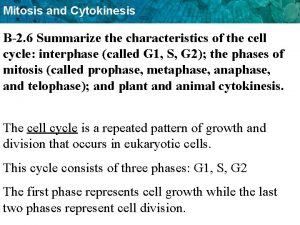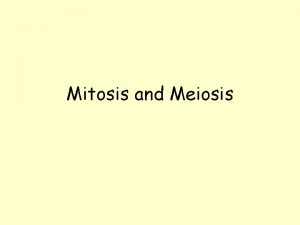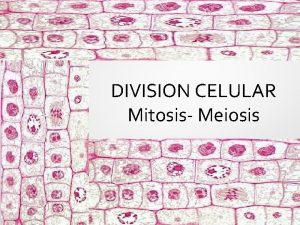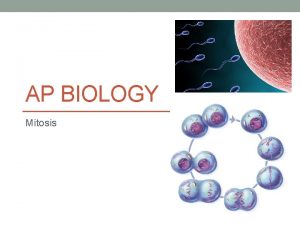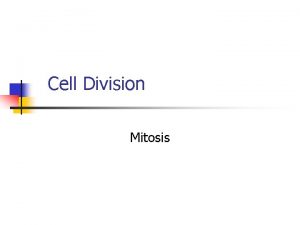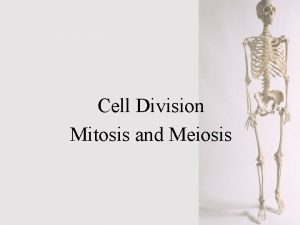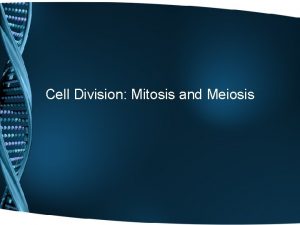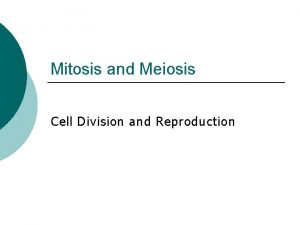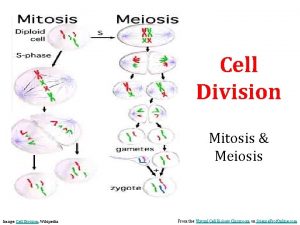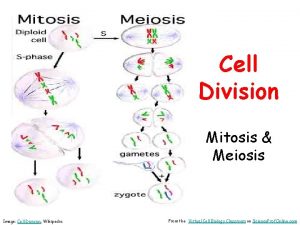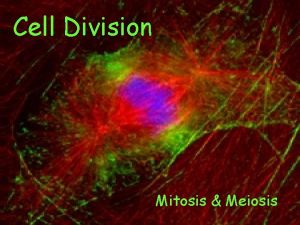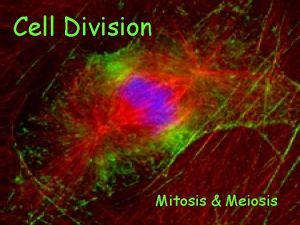Meiosis and Mitosis Cell Division and Sex Cell


















- Slides: 18

Meiosis and Mitosis Cell Division and Sex Cell Division By Mr. Heiselt

Terms to know: • Cell – Basic Unit of life • Chromosome – Strands of DNA that hold genetic information • Genes – Short sections of the Chromosome • Allele – Section of a gene that holds the data for a specific trait • Trait – the physical look of the organism (ie. Height skin tone, eye color, etc. ) • Reproduction – to create another organism with similar genetic information.

Cell Theory • There are three parts – The cell is the basic unit of structure and function of life – All cells come from other living cells – All living things are made up of cells

Why Do Cells Divide? • Cells must be replaced as they die or are lost. • Organisms cannot grow without adding new cells. • Organism Reproduction

Mitosis Cell Division for growth and replacement • Without Mitosis, we would waste away to nothing. Everyday you lose millions of cells. Imagine what would happen to you if they were NOT replaced? • To grow, you must have new cells to add to your mass and volume!

How Mitosis Works Mitosis is the process of creating two identical “daughter” cells from a single “mother” cell.

Mitosis as Reproduction • Some organisms use Mitosis for reproduction – this is asexual reproduction. • Here are some examples on the next few slides

Budding • Commonly used by small organisms like Hydras

Binary Fission • Common in most Protists and Bacteria. – The mother bacteria splits into two new daughter bacteria.

Fragmentation • This occurs in plants where a piece of the plant breaks off but can “replant” itself in new soil where it lands.

Spores • Many molds and fungi use this method. The adult produces spores containing their genetic information and lets them loose into the air or water.

Stolons • Common in Strawberry plants, the adult plant sends out long stems that take root when they land on soil. The adult stays connected to the offspring while it gets started.

Why Reproduce Asexually? • If you are already adapted to the environment – why change? Asexual Reproduction means your offspring survive like you did. • Lower occurrence of mutations. • No need for male and female genders. • All adults – no embryo, baby or child stage to survive.

e W f i t a h W t e u c B u d o r p e R ? y l l a u x Se

Sexually Produced offspring: • Receive ½ traits from Mother • Receive ½ traits from Father • Formed when the sex cells (Egg & Sperm) meet • Fertilization can occur inside or outside of the body.

How do we get Sex Cells? • Sex cells, or gametes, are formed through Meiosis. • Meiosis is like a double dose of mitosis but does not allow all the chromosomes to be copied (replicate) so each daughter cell only gets ½ of the DNA. • We call them Eggs and Sperm

To review: • Mitosis: Mother cell divides into two identical daughter cells with all the DNA

To Review • Meiosis is the process of creating sex cells with only ½ of the DNA.
 Mitosis meiosis
Mitosis meiosis Mitosis
Mitosis Kurt bumby
Kurt bumby Sex snv
Sex snv Xxtesticles
Xxtesticles Sex sex sex
Sex sex sex Sex sex sex
Sex sex sex Can you fill in the meiosis concept map
Can you fill in the meiosis concept map Mitosis bingo
Mitosis bingo Compare and contrast mitosis and meiosis
Compare and contrast mitosis and meiosis Difference between mitosis and meiosis
Difference between mitosis and meiosis Punnett square for sex linked traits
Punnett square for sex linked traits Sex determination in drosophilla
Sex determination in drosophilla Sex determination and sex linkage
Sex determination and sex linkage Whats the difference between mitosis and meiosis
Whats the difference between mitosis and meiosis Kesler science crossword answer key
Kesler science crossword answer key How are mitosis and meiosis similar
How are mitosis and meiosis similar Mitosis and meiosis youtube
Mitosis and meiosis youtube Mitosis purpose
Mitosis purpose


















